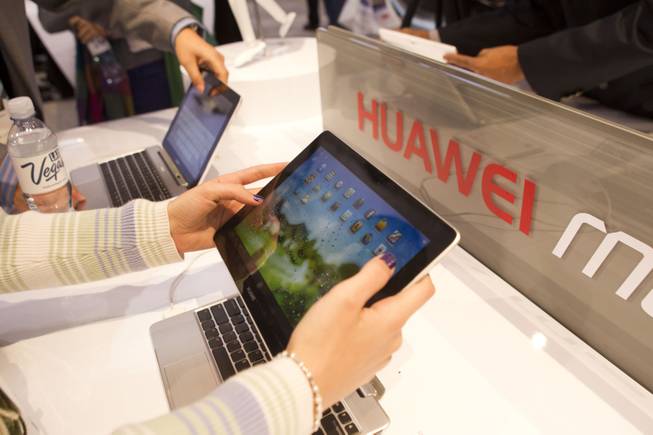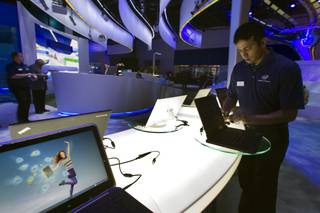
A woman looks over the Huawei MediaPad, a 10-inch Android-based notebook with detachable tablet, at the Huawei booth on the first day of the 2013 International CES in the Las Vegas Convention Center Tuesday, Jan. 8, 2013.
Wednesday, Jan. 9, 2013 | 5:05 p.m.
Pity the poor laptop.
The darling of the tech world just a couple of years ago, laptops have become one of the biggest casualties of the tablet phenomenon. For consumers enamored of touch-screen tablets, laptops suddenly seem like stale, clunky gadgets whose basic clamshell design hasn’t changed all that much in two decades.
It opens. It shuts. Yawn.
But this week at the 2013 International Consumer Electronics Show in Las Vegas, the laptop is attempting a comeback. The stodgy clamshell is being cast aside by manufacturers who are trying to create a new category of device that combines the feel and functions of tablets and laptops.
Call them hybrids. Call them convertibles. These new computers fold. They twist. They slide. They detach.
And, more importantly, they are spawning like crazy. This wild burst of experimentation is being driven by a number of trends that suddenly converged: thinner designs, better touch screens and the arrival in October of Windows 8, Microsoft Corp.’s new operating system designed for touch screens.
But there’s another crucial element: desperation. Industry insiders say laptops have to change quickly or face a long, slow decline.
“The impetus was the tablet,” said Nick Reynolds, Lenovo’s executive director for worldwide consumer products. “Unless the personal computer becomes interesting and personal again, it’s going to die.”
The explosion of these “multimode” laptop computers is the latest indicator of just how dramatically the computing industry has been turned upside down since Apple Inc.’s introduction of the first iPad almost three years ago.
Since then, sales of tablets have consistently exceeded even the most optimistic projections. Companies that were once leaders in selling personal computers and laptops, or the components such as chips and processors that go inside, were caught flat-footed by the turbocharged pace of change.
According to the Consumer Electronics Association, which hosts CES, tablets and smartphones, two categories that barely existed a few years ago, will account for 40 percent of global sales of all consumer electronic devices in the coming year.
Some companies have scrambled to build their own tablets, usually based on Google Inc.’s Android operating system, with some limited success. Last year, Microsoft unveiled its own tablet, Surface, based on the new Windows 8 platform.
But many other companies are trying to reinvent the laptop.
Glimpses of some of these devices were seen at the last CES. But since the release of Windows 8 in October, a trickle has turned into a flood. By the end of 2013, chip maker Intel Corp., which is making big bets on these new devices, is estimating that there could be as many as 140 varieties of these multimode computers on the market.
These new forms offer consumers unprecedented choice. The risk is that they also create confusion.
For instance, a consumer might consider a convertible Toshiba Satellite. Open the top, and you have a laptop running Windows 8 with a touch screen. Open until both halves lie flat, then slide the screen over the keyboard to switch to a tablet.
Or check out Lenovo’s Yoga, which the company calls a “flip and fold” because its hinges allow a user to open the screen and place it in four positions: tablet, laptop, tent or stand. The company also has the ThinkPad Twist, which opens and then lets the screen spin on an axle and close again so the screen faces up and hides the keyboard.
On Monday, Asus announced its 13-inch Transformer Book, a laptop with a detachable touch screen that can be used as a tablet.
As far as Intel is concerned, these devices are the future of computing. The chip giant, which dominates desktop computing, has struggled to get momentum in mobile devices such as tablets and smart phones.
During a news conference Monday, Intel executives spoke in front of a big display of these new-age laptops. The Santa Clara, Calif., company said it was moving up the release of the next version of its chips.
“We fundamentally believe that there’s a convergence happening between tablets and notebook,” said Kirk Skaugen, vice president and general manager of Intel’s Client Group.
The proliferation of designs reflects another uncomfortable truth: Laptop manufacturers don’t really know what consumers want when it comes to hybrids, or even if they want them. And so the manufacturers are taking a see-what-sticks-to-the-wall approach.
Patrick Moorhead, principal analyst at Moor Insights & Strategy, said he believes that some versions of these multi-mode laptops could catch on with consumers. The ability to have one device that lets users do work that still requires a keyboard and then switch to a tablet might have some appeal. And businesses might like these devices as a way to appease the growing number of employees who are asking for tablets but worry that iPads pose a security risk.
Moorhead said a few things still need to happen for multimode laptops to gain ground on tablets. The displays and battery life need to improve and cost needs to come down.
“If your convertible is just as good or nearly as good as that tablet, then you might see the tablet market start to take a hit,” he said. “But we’re still not at that point.”
Still, Skaugen of Intel projects that prices of some of these devices will drop to $599 in the coming year, putting them in the range of tablets. And as designers continue to play with the form, he’s optimistic that laptops could recapture the hearts of consumers.
“Last year, I said there would be more innovation in this next year than we had in the past decade in the notebook,” Skaugen said. “And I think that’s come to fruition.”


Join the Discussion:
Check this out for a full explanation of our conversion to the LiveFyre commenting system and instructions on how to sign up for an account.
Full comments policy